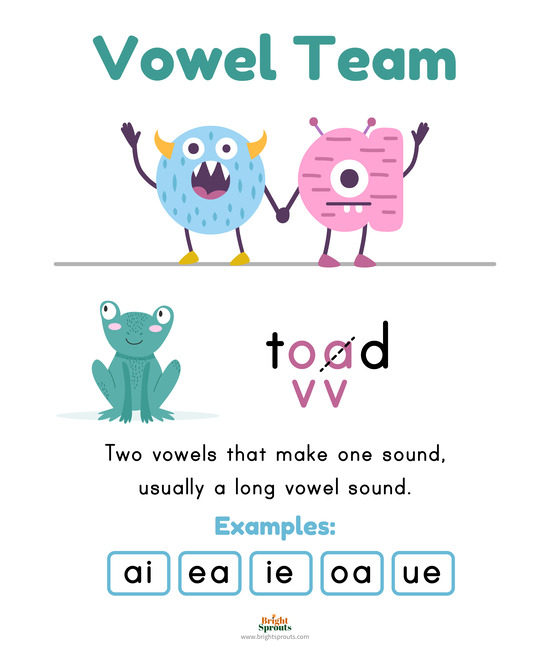Vowels teams are one of the most common phonemes but also one of the most challenging when it comes to reading and spelling, especially for younger students.
In a vowel team (also called a vowel digraph), two letters combine to make one vowel sound. It seems simple enough, but there are multiple spellings and exceptions. You’ll need to spend a lot of time on vowel teams to help your students build strong foundations.
We’ll cover everything you and your students need to know about vowel teams along with giving you some strategies for teaching and some helpful free worksheets.
What Is a Vowel Team?
Vowel teams are one of the seven types of syllables. In a word, a vowel team works together to make one sound. Words like main, treat, and dread all use vowel teams.

Vowel teams are challenging because the rules can be tricky. Vowel teams don’t always act in the manner in every context.
Consider the words “read” and “read.”
I read that book last year.
We have time to read in class each day.
Students need to be taught vowel teams systematically. There are no tricks that work for every case, so it’s best to take things slowly and be explicit in your teaching. Take the time to give your students a strong foundation.
Learning vowel teams is essential for helping students become better readers and spellers. Several vowel teams can often represent a specific sound, so kids need explicit instruction to help them learn all of the combinations.
Vowel teams can be split into two types: digraphs and diphthongs.
Digraphs
Most vowel teams are digraphs. A digraph is two letters that make one sound.
Digraphs can be made of vowel teams or consonant teams. Vowel digraphs can be made of vowels and consonants, as in the word “way.” The -ay vowel team creates the long A sound.
Vowel digraphs are much more challenging for students to learn because there are so many vowel digraphs for each vowel sound. Often, the same digraph will represent two different sounds, based on the word. Consonant digraphs are easier to hear and thus, easier to spell.
Diphthongs
Diphthongs are a special type of digraph. With a digraph, the two vowels combine to make one vowel sound, like the long A or short E sounds.
The vowels in a diphthong move from one vowel sound to another. Diphthongs often distort the normal vowel sound, making it neither short nor long.
Diphthong examples:
- brown
- coil
- near
It’s important to note that W and Y can act as vowels when paired with another vowel in a diphthong.
To clear up any confusion, all diphthongs are digraphs, but all digraphs are not diphthongs.
Split Digraph
Not all vowel digraphs have to be next to one another in a word. For a split digraph, there is a vowel followed by a consonant followed by E.
Digraph examples:
- cake
- bone
- nice
Many teachers teach the split digraph separately under the notion that the E at the end makes the middle vowel sound long. However, there are many exceptions, such as love and come.
Teachers should teach the split digraph and diphthongs as subsets of digraphs.
Vowel Team Sounds and Examples
There are five vowel team sounds, each representing a long vowel sound.
There are also diphthong sounds and some exceptions to the long vowel rule. Below are the main sounds and the different spellings that represent them along with vowel team words for examples.

Long A: ai, ea, ay, ey, eigh
Examples: raid, break, way, hey, eight
Long E: ea, ee, ey, ie, ei
Examples: seat, peel, valley, cookie, ceiling
Long I: igh, ie
Examples: sight, pie
Long O: oe, oa
Examples: toe, oatmeal
Long U: ue, eu, ew
Examples: due, feud, mew
Diphthong Sounds
Diphthong sounds are sometimes called sliding sounds as your voice moves from one vowel sound to another.
- au as in Australia
- aw as in saw
- oi as in void
- oo as in cool
- ou as in loud
- ow as in cow
- oy as in boy
Exceptions
As with most “rules” in the English language, there are exceptions. These exceptions are called “unpredictable vowel teams” or “code overlap.”
As you teach these rules, it’s important that you also teach the exceptions and give students time and practice to learn them.
- ea – team, dread, great
- ie – cried, belief
- oo – zoom, took
- ou – proud, group, double
- ow – how, blow
When Should You Introduce Vowel Teams?
Most teachers introduce vowel teams somewhere between the middle and end of first grade. Students will encounter vowel teams in kindergarten and early first grade as they begin reading sight words and decoding.
However, since vowel teams can be confusing, it’s best to wait until later to teach kids exactly how they work or ask kids to do any type of decoding activities with them.
How to Introduce Vowel Teams
One of the best strategies for teaching vowel teams is to start with sounds.
It’s often easier for kids to hear the sounds and learn the different spellings instead of starting with the spellings.
You should work on one sound at a time and go through each spelling for that sound. Make sure students have a good grasp of each sound and its spellings before moving to the next ones. Remember that your students are new readers and spellers, so vowel teams can be overwhelming.
Beginning to Work With Vowel Teams
Talking about vowel teams with your students is great and direct instruction plays an important role in any type of phonics learning. However, it’s important that as you introduce vowel teams, kids get a chance to do some hands-on work with each team and sound.
If they don’t already, your students need notebooks dedicated to word study (a composition book works well). This notebook should be used for them to record examples of the rules they learn and give them a chance to classify each sound and syllable.
For each vowel team, students should be given a set of examples. Using their notebooks, they can work with each word by classifying. They can use highlighters or colored pencils if you’d like them to color code it.

The students isolate the vowel team by writing it in a different color and labeling each with a V. The curved line shows that the two vowels work together to make one sound.
Other Vowel Teams Activities
After introducing vowel teams and letting students record examples in their notebooks, you can move on to vowel teams activities.
1. Sorting
Sorting is a simple yet effective activity for kids learning vowel digraphs. You can easily make word sorts as simple or complex as you want. When first learning vowel teams, students can sort one at a time. You can add in more as they advance.
2. Elkonin Sound Boxes
Elkonin sound boxes are used to help students hear the phonemes in a word instead of paying attention to the letters in isolation.
Elkonin sound boxes are made up of a word or a picture representation with enough boxes underneath to represent each sound/phoneme. Students use a counter or small block and slide across the boxes as they say the word, paying attention to each phoneme.
The students isolate the vowel team by writing it in a different color and labeling each with a V. The curved line shows that the two vowels work together to make one sound.
Download our free worksheet with a mix of vowel digraphs.

3. Missing Letters
As students get more experience with vowel teams, you can give them a worksheet with words that are missing vowel teams. Students will use the pictures and letter cues to figure out the words. They’ll need to rely on spelling skills to figure out which vowel team fits.
This activity can be made simple, focusing on one sound with two or three possible spellings. It can also be more complex with several different sounds.
Download our free printable to give students extra practice with vowel teams.

Things to Watch Out For
Vowel digraphs are complex, so there are a few pitfalls you’ll want to watch out for.
Don’t Forget Y and W
Remind kids that Y and W can act as vowels, but only in certain situations. Words like bow and every use the letters as vowels.
Give kids strategies for determining if a Y or W is used as a vowel. They can say the words out loud and see if they make a /y/ or /w/ sound. If not, it’s likely acting as a vowel.
Avoid “Cute” Generalizations
Teachers often use cute phrases to help their kids remember things. These mnemonics can be helpful as long as they’re true for every situation. Unfortunately, two of the biggest phrases used in phonics aren’t always correct.
The phrase “two vowels go walking, the first one does the talking,” refers to how many vowel teams make the long vowel sounds of the first vowel. However, many words don’t adhere to this rule. Steak and book are just a couple of words with vowel teams that don’t follow this rule.
If you choose to teach this rule, make sure your students are aware of all of the exceptions.
Teachers often use “sneaky e, baby e,” or other versions to help kids remember the silent e at the end of some words with a long vowel sound in the middle. However, it’s not the e making the long vowel sound, but rather the split digraph.
R-Controlled Vowels
Whenever the letter r follows a vowel, it creates an r-controlled vowel. The vowel sound is distorted and doesn’t make its normal short or long sound. R also affects vowel diphthongs. For example, in the word bear, the sound is neither long nor short.
It’s important to remind kids about r-controlled vowels (sometimes called “bossy r) when they’re learning vowel teams.
